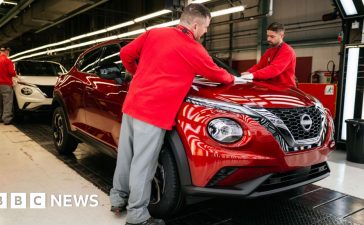Receive free Employment updates
We’ll send you a myFT Daily Digest email rounding up the latest Employment news every morning.
For several years now, politicians have insisted that the road to net zero is paved with jobs. “When I think climate, I think jobs,” US president Joe Biden is fond of saying. Not just any jobs, mind you, but good jobs that will revive deprived communities. Sir Keir Starmer, the Labour opposition leader in the UK, joined this chorus recently when he said the green transition could “bring back hope to communities that got ripped apart by deindustrialisation in the 1980s”.
I have been wary of this glossy narrative for some time, not because I think it’s impossible, but because I think it will be hard and involve trade-offs policymakers would rather not talk about. In recent weeks, that reality has become harder to ignore.
Why might a “win-win” for workers and the planet be hard to achieve? On paper, at least, the challenge doesn’t look too daunting. According to calculations by the IMF last year, the green transition should only involve the “reallocation” of 1 per cent of employment in advanced economies over the next decade, and 2.5 per cent in emerging markets. That, the IMF noted, is much less dramatic than the transition from manufacturing to services since the 1980s, which involved a shift of 4 per cent per decade. On top of that, the average “green” job pays almost 7 per cent more than the average “brown” job, which — all else being equal — should encourage people to switch, and make them better off when they do.
But in the real world, of course, people don’t “reallocate” as easily as swapping from one row on an economist’s spreadsheet to the next. First, there is the question of geography: so far, at least, work by the OECD shows green jobs are disproportionately to be found in capital regions, while brown jobs are disproportionately in regions with lower gross domestic product per capita. Then there is the question of retraining: the OECD found that only 12 per cent of people in brown jobs are participating in life-long learning or training, compared with 19 per cent of people in “neutral” and green jobs.
Drill down into sectors at the forefront of the transition and the challenges become clearer. From energy to cars to steel, the new green production processes are generally less labour-intensive — good for consumers, since this should eventually mean lower prices, but not so good for workers.
In the UK this month, a deal to decarbonise the country’s biggest steelworks in Port Talbot in Wales demonstrated how easily the narrative about green jobs can turn sour. The UK government agreed to pay subsidies of up to £500mn to Tata Group to secure the future of the plant by replacing blast furnaces with an electric arc furnace, which requires less labour and will involve the loss of 3,000 jobs. Unions, who said they had been cut out of the discussions, had wanted a different plan involving hydrogen, which they said could have preserved jobs while expanding output, albeit with a higher price tag and slower timeline. The government said that was unrealistic, and pointed out the deal had secured the other 5,000 jobs.
Either way, the attack line was obvious, and Labour wasn’t afraid to use it. “Only the Tories could spend £500mn of taxpayers’ money to make thousands of British workers redundant,” quipped Jonathan Reynolds, the shadow business secretary. The government has promised £100mn for regeneration and retraining to “ensure that the transition is as appropriate as it can be”, but communities like Port Talbot have heard promises like these before. The steel jobs pay roughly £36,000 to £38,000 in a community where most other jobs aren’t much above minimum wage, according to Alun Davies, the national officer for steel at the Community Union. “The reports of 3,000 jobs lost is going to be more like 11,000 because of the downstream businesses, the contractors, the local shops . . . What are they going to do? Build another industrial estate there and fill it full of minimum-wage jobs?”
In the US, the Biden administration has thought more seriously about how to make the transition work for communities on the sharp end, for example by offering additional incentives to clean energy companies that invest in former coal regions. But even so, there are fears it won’t be enough. Meanwhile, new electric vehicle plants are clustering in southern states where labour standards and unionisation rates are lower, much to the unions’ dismay.
In countries such as Germany, more innovative ideas are under discussion. IG Metall, the country’s biggest union, plans in November to bargain for a four-day week for steel workers as a way to respond to the need for less labour in future. “Generally speaking, we are still quite optimistic that the green transition is a necessary thing and can be managed if workers’ interests are taken into account,” says Thorben Albrecht, policy director at IG Metall. The key, he says, is not to pretend there aren’t difficult decisions ahead but to make sure workers have a seat at the table when they are made.
The worst approach would be to cut workers out of the conversation, then call them climate change sceptics, populists or — even more insulting — “stirred up” by populists, when they object. “A lot of people are turning their backs now on the green transition,” Davies told me after the Port Talbot deal. “Some people are saying, ‘do you know what? I prefer my job.’”
Sarah O’Connor is going on book leave and will back in April 2024
Climate Capital

Where climate change meets business, markets and politics. Explore the FT’s coverage here.
Are you curious about the FT’s environmental sustainability commitments? Find out more about our science-based targets here








